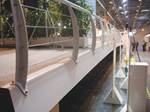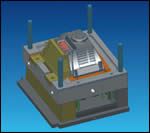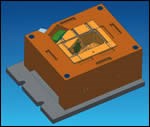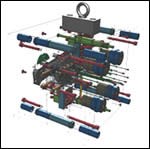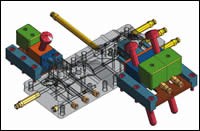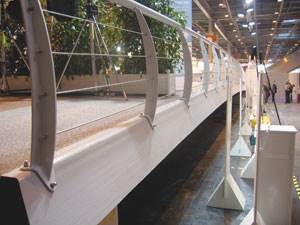Moving Mold Design From 2-D to 3-D
Moving to 3-D mold design can provide a very effective way of improving competitiveness and helping companies win more business.
Most mold shops already use 3-D CAD techniques to develop the cores and cavities of their tools. More recently, software has been introduced to enable not just the core and cavity but the complete mold design to be developed in 3-D. Software suppliers have made big claims for the potential improvements in productivity that could be gained. Even so, until now the majority of mold designers have continued to work with their 2-D methods.
Reluctance to Change
Two reasons can be suggested for this reluctance to change:
1. The use of 3-D for core and cavity work has become almost inevitable as more and more product designs are supplied as 3-D models rather than as 2-D drawings (see Figure 1). In addition, the increasing complexity of many designs has made CAM pro-gramming the only practical way to machine the more complicated cores and cavities. In contrast, the simpler shapes used for most of the other components in the tool mean that there is not the same pressure to abandon 2-D methods. Standard components used in mold tools can be described adequately in 2-D, while holes and pockets can be machined satisfactorily using the machine tool control.
2. Many of the companies supplying 3-D mold design software seem to have highlighted the wrong benefits when trying to persuade companies to change. In some cases, software developers seem to be giving the impression that the user simply needs to read in the product design and then push a couple of buttons to make the finished mold design appear. Apart from being totally misleading, such claims completely miss the point of investing in software.
It should not be about trying to de-skill complex tasks so that North American manufacturers can employ cheaper labor and compete with Asian economies over who can pay the least. Instead, the real aim should be to make skilled workers more productive so that companies can be more cost-effective in producing high-quality tools in shorter leadtimes. Automation of routine operations means that standard calculations can be carried out more quickly and with less chance of errors. Then, the time saved can be used by skilled toolmakers to focus on the key decisions to be made over the design and operation of the mold.
Employing a Team Effort
In other cases, the software supplier’s emphasis has been on speeding design times. However, the biggest time saving is not in generating the initial design, but in the subsequent downstream machining and assembly operations.
Focusing simply on speed of design ignores the inherent management difficulties in using a combination of methods, with the core and cavity being designed and manufactured by a single team using 3-D methods and the components making up the rest of the mold being produced by a second group using 2-D drawing and machining techniques. Even with careful planning, it is difficult to ensure that all the various parts of the tool can be delivered in the correct sequence for assembly.
Furthermore, any changes to the product design that might affect the tool design must be communicated to both teams. Having two separate groups effectively doubles the chance that someone will be working with an out-of-date data. In contrast, having a single team, working with the same 3-D system, makes it easier to prioritize tasks and to ensure that everyone involved is using the correct data.
Eliminating Mistakes
Significant improvements also can be made through eliminating mistakes during both design and manufacture. Two-dimensional drawings can be ambiguous and it is much more difficult to ensure consistency in a large number of drawings than it is with a single computer model. Errors in dimensions and positions within drawings can be impossible to spot until the final assembly stage is reached. Of course, even a single mistake, such as a hole in the wrong position in one component, can cause serious delays at this stage. In contrast, with a 3-D computer model, realistic representations of the individual components and computer simulations of the mold’s movement will help ensure both that the individual components will fit together successfully and that the mold will operate as expected (see Figure 2).
Speeding Downstream Operations
In most cases, more significant timesavings come from the speeding of downstream manufacturing operations than from improving design productivity. Direct links from the mold design software to the CAM package allow much faster, more automated programming and help ensure highly reliable machining of both holes and pockets. Again these benefits are not about using less skilled people for CAM programming, but about allowing the experienced programmers to focus on the more complex challenges involved in machining the core and cavity.
In addition, development in inspection software means that each component can be inspected as it is produced, allowing any problems to be resolved immediately and ensuring that the final assembly of the mold proceeds smoothly.
The 3-D Balance in Savings
Two examples illustrate the balance in the savings possible with 3-D mold design. The first was the mold for the back cover of a television (see Figure 3). Here the design time was reduced from 14 days with the previous 2-D system to 11 days with 3-D software. A significant saving, of course, but paling in comparison with a reduction in the machining and assembly time from eight and a half days to two days. The differences were even more dramatic with the second example: a mold for an air cleaner cover (see Figure 4). In this case, the simpler component meant that design time was unchanged at seven days with both 2-D and 3-D methods. However, the machining and assembly time went down from eight days to a single day.
The second example illustrates the potential problem companies may possibly experience when first changing to 3-D methods. As with any new way of operating, the training time required and the need to become familiar with the new techniques may limit the benefits to be seen at first. Furthermore, mold designers always should try out their new processes on simpler product designs while learning the system. These types of projects will see the smallest gains in design times compared to 3-D methods.
However, once staff has become used to the new way of working and has begun to tackle more complex examples, the company should see considerable improvements, not simply in designs times but in the overall mold production time. Reduced errors also should contribute to significant cuts in waste and rework. Together these improvements from moving to 3-D mold design can provide a very effective way of improving competitiveness and helping companies win more business.
Related Content
Four Micro Tooling Considerations
Issues involving gating, ejection, mold splits and direction of pull are of special concern when it comes to micro tooling.
Read MoreWhat Is Scientific Maintenance? Part 1
Part one of this three-part series explains how to create a scientific maintenance plan based on a toolroom’s current data collection and usage.
Read MoreHow to Analyze and Optimize Cutting Conditions to Reduce Cycle Time
Plastic injection mold design and manufacturing company puts NC program optimization software module to the test. The results were surprising.
Read MoreLeading Mold Manufacturers Share Best Practices for Improving Efficiency
Precise Tooling Solutions, X-Cell Tool and Mold, M&M Tool and Mold, Ameritech Die & Mold, and Cavalier Tool & Manufacturing, sit down for a fast-paced Q&A focused on strategies for improving efficiencies across their operations.
Read MoreRead Next
Rediscovering CAM
Exploring underused CAM features that can improve moldmaking productivity and trim operating costs.
Read MoreHow to Use Strategic Planning Tools, Data to Manage the Human Side of Business
Q&A with Marion Wells, MMT EAB member and founder of Human Asset Management.
Read MoreReasons to Use Fiber Lasers for Mold Cleaning
Fiber lasers offer a simplicity, speed, control and portability, minimizing mold cleaning risks.
Read More
